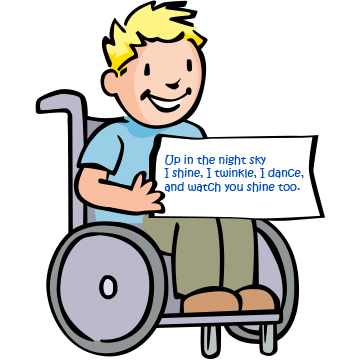Boston Children's Museum
308 Congress Street, Boston, MA 02210
617-426-6500
© Boston Children’s Museum 2025
Website Design by JackrabbitLooking up at the sky has inspired scientists, artists, musicians, poets, writers, and cultures around the world for thousands of years. Few things are as universally stirring, and while cultures and landscapes may vary around the world, the sky above us unites us all and finds expression in many forms. One of these forms is haiku, which is not only a low-barrier introduction to elements of poetry like form, sound, meter, mood, dominant impression, and more; it is also a way to connect with the science of “looking up”, to build vocabulary, and to learn more about a tradition from another culture.
This is an activity you can pull out often, using it as a chance to review any new words they have learned recently, particularly if you have focused on one subject (like astronomy). You could use a “word tray” for this activity, which you should create in advance (click here for an example of a word tray). Better yet, create just such a list with the kids – see instructions for this in the “Make it Happen” step. Lists like these can help students with their work, and creating haiku encourages children to use new vocabulary in context, which helps you to assess their understanding.
Print the NASA Inspirations images from this curriculum (See Optional Materials), or show them on a computer, or even projected on a wall. If this is your first time printing these images, keep them – they can be used for a few other activities in this curriculum. You may want to laminate them to keep them in good shape.

Ask your students if any of them have ever heard of (or even been to) Japan before. Where is it on Earth (locate it together on a map, globe, Google Earth, etc. if you have it available)? Tell your students that in Japan, there is a traditional form of poetry called “haiku”. Have any of your students heard of haiku before? Find a haiku (click here for some examples) you like and read it to your children. Ask them what they thought about after hearing the poem that you read. Read some more haiku, if you like, then explain the format of haiku. Haiku are traditional Japanese poems with the following rules:
Get inspired by the universe and express it through Haiku poetry.
After each child has created a poem, gather everyone together in a group. What kinds of feelings did they try to include in their haiku? Is it thought provoking? Is it humorous? Is it peaceful? Is it serious? Does it refer to smell, taste, and other senses? Ask any kids who would like to read their poem to the rest of the group to do so (you might need to write and read your own to get things started). Some afterschools have had a lot of fun organizing dramatic readings of the haikus. Try something like that yourself!
After talking about the process, and possibly hearing other haiku, children can go back to their poems and continue working on them, or even write new haiku. Share some more poems after your children have had a chance to create some more.
Earth and Space science activities were developed with the support of NASA. This material is based upon work supported by NASA under grant award number NNX14AQ83G. Any opinions, findings, and conclusions or recommendations expressed in this material are those of the author(s) and do not necessarily reflect the views of the National Aeronautics and Space Administration (NASA).